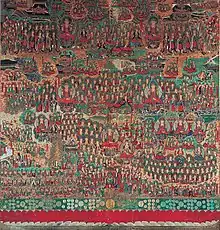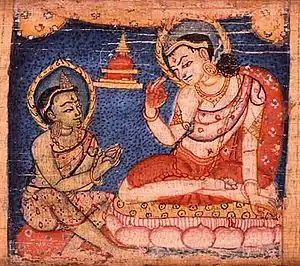Avatamsaka Sutra
The Avataṃsaka Sūtra (IAST, Sanskrit: आवतंसक सूत्र); or the Mahāvaipulya Buddhāvataṃsaka Sūtra (Sanskrit: महावैपुल्य बुद्धावतंसक सूत्र), is one of the most influential Mahāyāna sutras of East Asian Buddhism. The title is rendered in English as Flower Garland Sutra, Flower Adornment Sutra, or Flower Ornament Scripture. It has been called by the translator Thomas Cleary "the most grandiose, the most comprehensive, and the most beautifully arrayed of the Buddhist scriptures."[1]
_-_BL_Or._7377.jpg.webp)
| Part of a series on |
| Mahāyāna Buddhism |
|---|
 |
The Avataṃsaka Sūtra describes a cosmos of infinite realms upon realms, mutually containing one another. This sutra was especially influential in East Asian Buddhism.[2] The vision expressed in this work was the foundation for the creation of the Huayan school of Chinese Buddhism, which was characterized by a philosophy of interpenetration. The Huayan school is known as Hwaeom in Korea and Kegon in Japan. The sutra is also influential in Chan Buddhism.[2]
Title
This work has been used in a variety of countries. Some major traditional titles include the following:
- Sanskrit: Mahāvaipulya Buddhāvataṃsaka Sūtra, "The Great Vaipulya Sutra of the Buddha's Flower Garland." Vaipulya ("extensive") refers to key sizable, inclusive sūtras.[3] "Flower garland/wreath/adornment" refers to a manifestation of the beauty of Buddha's virtues[4] or his inspiring glory.[N.B. 1]
- Chinese: Dàfāngguǎng Fóhuāyán Jīng Chinese: 大方廣佛華嚴經, commonly known as the Huāyán Jīng (Chinese: 華嚴經), meaning "Flower-adorned (Splendid & Solemn) Sūtra." Vaipulya here is translated as "corrective and expansive", fāngguǎng (方廣).[7] Huā (華) means at once "flower" (archaic, namely 花) and "magnificence." Yán (嚴), short for zhuàngyán (莊嚴), means "to decorate (so that it is solemn, dignified)."
- Japanese: Daihōkō Butsu-kegon Kyō (大方広仏華厳経), usually known as the Kegon Kyō (華厳経). This title is identical to Chinese above, just in Shinjitai characters.
- Korean: 대방광불화엄경 Daebanggwang Bulhwaeom Gyeong or Hwaeom Gyeong (화엄경), the Sino-Korean pronunciation of the Chinese name.
- Vietnamese: Đại phương quảng Phật hoa nghiêm kinh, shortened to the Hoa nghiêm kinh, the Sino-Vietnamese pronunciation of the Chinese name.
- Tibetan: མདོ་ཕལ་པོ་ཆེ།, Wylie: mdo phal po che , Standard Tibetan Do phalpoché
According to a Dunhuang manuscript, this text was also known as the Bodhisattvapiṭaka Buddhāvataṃsaka Sūtra.[6]
History
The Avataṃsaka Sūtra was written in stages, beginning from at least 500 years after the death of the Buddha. One source claims that it is "a very long text composed of a number of originally independent scriptures of diverse provenance, all of which were combined, probably in Central Asia, in the late third or the fourth century CE."[8] Japanese scholars such as Akira Hirakawa and Otake Susumu meanwhile argue that the Sanskrit original was compiled in India from sutras already in circulation which also bore the name "Buddhavatamsaka".[9]
Two full Chinese translations of the Avataṃsaka Sūtra were made. Fragmentary translation probably began in the 2nd century CE, and the famous Ten Stages Sutra, often treated as an individual scripture, was first translated in the 3rd century. The first complete Chinese version was translated by Buddhabhadra around 420 in 60 scrolls with 34 chapters,[10] and the second by Śikṣānanda around 699 in 80 scrolls with 40 chapters.[11][12] There is also a translation of the Gaṇḍavyūha section by Prajñā around 798. The second translation includes more sutras than the first, and the Tibetan translation, which is still later, includes many differences with the 80 scrolls version. Scholars conclude that sutras were being added to the collection.
The single extant Tibetan version was translated from the original Sanskrit by Jinamitra et al. at the end of ninth century.[13]
According to Paramārtha, a 6th-century monk from Ujjain in central India, the Avataṃsaka Sūtra is also called the "Bodhisattva Piṭaka."[6] In his translation of the Mahāyānasaṃgrahabhāṣya, there is a reference to the Bodhisattva Piṭaka, which Paramārtha notes is the same as the Avataṃsaka Sūtra in 100,000 lines.[6] Identification of the Avataṃsaka Sūtra as a "Bodhisattva Piṭaka" was also recorded in the colophon of a Chinese manuscript at the Mogao Caves: "Explication of the Ten Stages, entitled Creator of the Wisdom of an Omniscient Being by Degrees, a chapter of the Mahāyāna sūtra Bodhisattvapiṭaka Buddhāvataṃsaka, has ended."[6]
Overview

The sutra, among the longest Buddhist sutras, is a compilation of disparate texts on various topics such as the Bodhisattva path, the interpenetration of phenomena (dharmas), the visionary powers of meditation and the equality of things in emptiness.[14] According to Paul Demiéville, the collection is "characterized by overflowing visionary images, which multiply everything to infinity, by a type of monadology that teaches the interpenetration of the one whole and the particularized many, of spirit and matter" and by "the notion of a gradual progress towards liberation through successive stages and an obsessive preference for images of light and radiance."[15] Likewise, Alan Fox has described the sutra's worldview as "fractal", "holographic" and "psychedelic".[16]
The East Asian view of the text is that it expresses the universe as seen by a Buddha (the Dharmadhatu), who sees all phenomena as empty and thus infinitely interpenetrating, from the point of view of enlightenment.[15] This interpenetration is described in the Avatamsaka as the perception "that the fields full of assemblies, the beings and aeons which are as many as all the dust particles, are all present in every particle of dust."[17] Thus, a buddha's view of reality is also said to be "inconceivable; no sentient being can fathom it".[17] Paul Williams notes that the sutra speaks of both Yogacara and Madhyamaka doctrines, stating that all things are empty of inherent existence and also of a "pure untainted awareness or consciousness (amalacitta) as the ground of all phenomena".[18] The Avatamsaka sutra also highlights the visionary and mystical power of attaining the spiritual wisdom which sees the nature of the world:
Endless action arises from the mind; from action arises the multifarious world. Having understood that the world's true nature is mind, you display bodies of your own in harmony with the world. Having realized that this world is like a dream, and that all Buddhas are like mere reflections, that all principles [dharma] are like an echo, you move unimpeded in the world (Trans in Gomez, 1967: lxxxi)[18]
As a result of their meditative power, Buddhas have the magical ability to create and manifest infinite forms, and they do this in many skillful ways out of great compassion for all beings.[19]
- In all atoms of all lands
- Buddha enters, each and every one,
- Producing miracle displays for sentient beings:
- Such is the way of Vairocana....
- The techniques of the Buddhas are inconceivable,
- All appearing in accord with beings’ minds....
- In each atom the Buddhas of all times
- Appear, according to inclinations;
- While their essential nature neither comes nor goes,
- By their vow power they pervade the worlds.(Cleary 1984–7: I, Bk 4)
The point of these teachings is to lead all beings through the ten bodhisattva levels to the goal of Buddhahood (which is done for sake of all other beings). These stages of spiritual attainment are also widely discussed in various parts of the sutra (book 15, book 26). The sutra also includes numerous Buddhas and their Buddhalands which are said to be infinite, representing a vast cosmic view of reality, though it centers on a most important figure, the Buddha Vairocana (great radiance). Vairocana is a cosmic being who is the source of light and enlightenment of the 'Lotus universe', who is said to contain all world systems.[15] According to Paul Williams, the Buddha "is said or implied at various places in this vast and heterogeneous sutra to be the universe itself, to be the same as ‘absence of intrinsic existence’ or emptiness, and to be the Buddha's all-pervading omniscient awareness."[19] The very body of Vairocana is also seen as a reflection of the whole universe:
The body of [Vairocana] Buddha is inconceivable. In his body are all sorts of lands of sentient beings. Even in a single pore are countless vast oceans.[20]
Also, for the Avatamsaka, the historical Buddha Sakyamuni is simply a magical emanation of the cosmic Buddha Vairocana.[19]
Sections and Themes
Luis Gomez notes that there is an underlying order to the collection. The discourses in the sutra version with 39 chapters are delivered to eight different audiences or "assemblies" in seven locations such as Bodh Gaya and the Tusita Heaven. Following the Chinese tradition, Gomez states that the major themes in each "assembly" are:[21]
- The Buddha at the moment of enlightenment is one with Vairocana (books 1-5)
- The Four Noble Truths form the basis for the bodhisattva's practice and liberation (books 6-12)
- The bodhisattva's progress, from initial aspiration to the highest station in the bodhisattva's path, described in ten 'abodes' or viharas (books 13-18)
- Ten types of conduct (carya) of bodhisattvas (books 19-22)
- Ten dedications of merit (books 23-25)
- Ten stages (bhūmi) of the bodhisattvas (books 26-37, book 26 is the "Ten stages sutra")
- A summary of themes that form the core of the collection (themes 3 to 5 of this list; book 38)
- The bodhisattva Sudhana's career and inconceivable liberation (book 39, Gaṇḍavyūha Sutra)
Two of the chapters also circulated as independent sutras in China and India (The Gandavyuha and the Ten Stages Sutra). These two are the only sections of the Avatamsaka which survive in Sanskrit.[14]
Ten Stages
The sutra is also well known for its detailed description of the course of the bodhisattva's practice through ten stages where the Ten Stages Sutra, or Daśabhūmika Sūtra (十地經, Wylie: 'phags pa sa bcu pa'i mdo ), is the name given to this chapter of the Avataṃsaka Sūtra. This sutra gives details on the ten stages (bhūmis) of development a bodhisattva must undergo to attain supreme enlightenment. The ten stages are also depicted in the Laṅkāvatāra Sūtra and the Śūraṅgama Sūtra. The sutra also touches on the subject of the development of the "aspiration for Enlightenment" (bodhicitta) to attain supreme buddhahood.
Gaṇḍavyūha

The last chapter of the Avatamsaka circulates as a separate and important text known as the Gaṇḍavyūha Sutra (flower-array, or 'bouquet';[22] 入法界品 ‘Entering the Dharma Realm’[23]). Considered the "climax" of the larger text,[24] this section details the pilgrimage of the layman Sudhana to various lands (worldly and supra-mundane) at the behest of the bodhisattva Mañjuśrī to find a spiritual friend who will instruct him in the ways of a bodhisattva. According to Luis Gomez, this sutra can also be "regarded as emblematic of the whole collection."[21]
Despite the former being at the end of the Avataṃsaka, the Gaṇḍavyūha and the Ten Stages are generally believed to be the oldest written chapters of the sutra.[25]
English translations
The Avataṃsaka Sūtra was translated in its entirety from the Śikṣānanda edition by Thomas Cleary, and was divided originally into three volumes. The latest edition, from 1993, is contained in a large single volume spanning 1656 pages.
- The Flower Ornament Scripture : A Translation of the Avatamsaka Sūtra (1993) by Thomas Cleary,[26] ISBN 0-87773-940-4
In addition to Thomas Cleary's translation, the City of Ten Thousand Buddhas is translating the Avataṃsaka Sūtra[27] along with a lengthy commentary by Venerable Hsuan Hua. Currently over twenty volumes are available, and it is estimated that there may be 75-100 volumes in the complete edition. The publisher Bukkyo Dendo Kyokai is also editing a full multi-volume translation which should be available around 2022.
See also
- Indra's net
- List of sutras
- Mahayana sutras
- Shin'yaku Kegonkyō Ongi Shiki, an early Japanese annotation
- Huayan, named after this sutra
- Simulation hypothesis
References
- The Divyavadana also calls a Śrāvastī miracle Buddhāvataṃsaka, namely, he created countless emanations of himself seated on lotus blossoms.[5][6]
- Cleary, Entry into the Inconceivable: An Introduction to Hua-Yen Buddhism, http://www.shambhala.com/an-introduction-to-the-flower-ornament-sutra/
- Cleary, The Flower Ornament Scripture: A Translation of the Avatamsaka Sutra, 1993, page 2.
- Keown, Damien (2003). A Dictionary of Buddhism. Oxford University Press. ISBN 978-0-19-860560-7.
- Akira Hirakawa; Paul Groner (1990). A history of Indian Buddhism: from Śākyamuni to early Mahāyāna. University of Hawaii Press. ISBN 978-0-8248-1203-4. Retrieved 12 June 2011.
The term "avatamsaka" means "a garland of flowers," indicating that all the virtues that the Buddha has accumulated by the time he attains enlightenment are like a beautiful garland of flowers that adorns him.
- Akira Sadakata (15 April 1997). Buddhist Cosmology: Philosophy and Origins. Kōsei Pub. Co. p. 144. ISBN 978-4-333-01682-2. Retrieved 12 June 2011.
...adornment, or glorious manifestation, of the Buddha[...]It means that countless buddhas manifest themselves in this realm, thereby adorning it.
- Ōtake Susumu (2007), "On the Origin and Early Development of the Buddhāvataṃsaka-Sūtra", in Hamar, Imre (ed.), Reflecting Mirrors: Perspectives on Huayan Buddhism, Otto Harrassowitz Verlag, pp. 89–93, ISBN 978-3-447-05509-3, retrieved 12 June 2011
- Soothill, W.E.; Hodous, Lewis (1937). A Dictionary of Chinese Buddhist Terms. London: Trübner. Archived from the original on 2009-03-02.CS1 maint: bot: original URL status unknown (link)
- Gimello, Robert M. (2005) [1987]. "Huayan". In Jones, Lindsay (ed.). Encyclopedia of Religion. 6 (2nd ed.). Detroit: Macmillan. pp. 4145–4149. ISBN 978-0-02-865733-2.
- Hamar, Imre (Editor). Reflecting Mirrors: Perspectives on Huayan Buddhism (ASIATISCHE FORSCHUNGEN), 2007, page 92
- "Taisho Tripitaka No. 278". Archived from the original on 2012-06-18. Retrieved 2012-06-02.
- "Taisho Tripitaka No. 279". Archived from the original on 2012-05-23. Retrieved 2012-06-02.
- Hamar, Imre (2007), The History of the Buddhāvataṃsaka Sūtra. In: Hamar, Imre (editor), Reflecting Mirrors: Perspectives on Huayan Buddhism (Asiatische Forschungen Vol. 151), Wiesbaden: Harrassowitz, ISBN 344705509X, pp.159-161
- Hamar, Imre (Editor). Reflecting Mirrors: Perspectives on Huayan Buddhism (ASIATISCHE FORSCHUNGEN), 2007, page 87
- Takeuchi Yoshinori (editor). Buddhist Spirituality: Indian, Southeast Asian, Tibetan, and Early Chinese, page 160
- Takeuchi Yoshinori (editor). Buddhist Spirituality: Indian, Southeast Asian, Tibetan, and Early Chinese, page 161
- Fox, Alan. The Practice of Huayan Buddhism, 2015.04, http://www.fgu.edu.tw/~cbs/pdf/2013%E8%AB%96%E6%96%87%E9%9B%86/q16.pdf Archived 2017-09-10 at the Wayback Machine
- Paul Williams, Anthony Tribe, Alexander Wynne. Buddhist Thought: A Complete Introduction to the Indian Tradition, page 168.
- Williams, Paul. Mahāyāna Buddhism: The Doctrinal Foundations, page 121.
- Williams, Paul. Mahāyāna Buddhism: The Doctrinal Foundations, page 122.
- Ryûichi Abé. The Weaving of Mantra: Kûkai and the Construction of Esoteric Buddhist Discourse, page 285
- Takeuchi Yoshinori (editor). Buddhist Spirituality: Indian, Southeast Asian, Tibetan, and Early Chinese, page 164
- Warder, A. K. Warder (2000). Indian Buddhism. Motilal Banarsidass. p. 402. ISBN 978-81-208-1741-8.
The title Gaṇḍavyūha is obscure, being generally interpreted as 'array of flowers', 'bouquet'. it is just possible that the rhetorical called gaṇḍa, a speech having a double meaning (understood differently by two hearers), should be thought of here.
- Hsüan-hua; International Institute for the Translation of Buddhist Texts (Dharma Realm Buddhist University) (1 January 1980). Flower Adornment Sutra: Chapter 39, Entering the Dharma Realm. Dharma Realm Buddhist Association. p. xxi. ISBN 978-0-917512-68-1.
- Doniger, Wendy (January 1999). Merriam-Webster's Encyclopedia of World Religions. Merriam-Webster. p. 365. ISBN 978-0-87779-044-0.
- Fontein, Jan (1967). The pilgrimage of Sudhana: a study of Gandavyuha illustrations. Walter de Gruyter. ISBN 978-3-11-156269-8.
- Cleary, Thomas (1993). The flower ornament scripture : a translation of the Avatamsaka Sutra. Boston u.a.: Shambhala. ISBN 9780877739401. Archived from the original on 19 April 2014. Retrieved 28 September 2014.
- "The Great Means Expansive Buddha Flower Adornment Sutra". THE SAGELY CITY OF TEN THOUSAND BUDDHAS. Buddhist Text Translation Society. Retrieved 28 September 2014.
Further reading
Prince, Tony (2020), Universal Enlightenment - An introduction to the Teachings and Practices of Huayen Buddhism (2nd edn.) Amazon Kindle Book, ASIN: B08C37PG7G
External links
| Chinese Wikisource has original text related to this article: |
| Wikiquote has quotations related to: Avatamsaka Sutra |
- The Avatamsaka Sutra (the Flower Adornment Sutra) with explanation
- Introducing the Avatamsaka Sutra - an outline of the sutra by a disciple of Master Hsuan Hua
- Articles by Imre Hamar
- 大方廣佛華嚴經 Avataṃsakasūtra Chinese text with matching English vocabulary at NTI Reader digital library